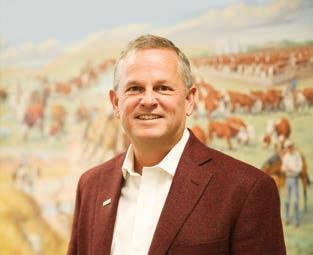
2 minute read
Breed Focus
by Jack Ward
Jack Ward is the executive vice president of the American Hereford Association. He can be reached at jward@hereford.org.
Historic Opportunity
Team Hereford has never been more important.
Heterosis pays, and heterosis created with Hereford genetics pays even more. The truth of both statements is verified by credible research spanning decades.
Research conducted at the U.S. Meat Animal Research Center (USMARC), Simplot Ranches, Harris Ranches and Circle A Ranch documented performance advantages associated with direct heterosis in Hereford-sired F1 cattle versus their straightbred contemporaries. The research also documented the performance and economic advantages resulting from maternal heterosis in Hereford-sired F1 females compared to their straightbred peers.
Keep in mind that maternal heterosis is unmatched at improving lowly heritable traits such as fertility and longevity. As you’ve heard, fertility is 10 times more important than any other trait when it comes to the profitability of a commercial cow-calf operation.
Moreover, the USMARC 2000 bull project proved that Hereford is the most unrelated of the of Bos Taurus breeds. Consequently, Hereford provides more heterosis in crossbreeding than other Bos Taurus breeds.
Yet, some commercial producers remain reluctant to utilize crossbreeding. Others who embrace heterosis have yet to learn how different the Hereford breed is today compared to two decades ago.
The 1881 booklet you received with this issue of Hereford World illustrates Hereford’s genetic improvement over time, how it was possible and the industry opportunity to enhance production efficiency and sustainability by incorporating more crossbreeding that includes Hereford genetics.
Hereford genetics provide solutions
The booklet also defines the historic opportunity Hereford breeders have to gain market share when the industry begins building back at least 2.5 million beef cows culled during the current drought.
Various data over time suggests commercial cow herd performance has remained static or declined when it comes to key revenue metrics like reproductive efficiency, weaning weight and weaning weight per cow exposed. Higher input costs and challenging margins demand producers do more with less — harness more production efficiency, the hallmark Hereford advantage.
So, Hereford opportunity to expand market share is magnified by the industry’s need to incorporate more heterosis as it rebuilds the cow herd.
Plus, society is demanding more of beef production. Today, more consumers, companies and lenders want documentation of how cattle and beef production impact global warming. Hereford is the first to document breed genetic relationships with methane production and nitrogen excretion via a collaborative research production between the American Hereford Association (AHA) and AgNext at Colorado State University.
Grab hold of 1881
Moreover, the booklet serves as a playbook of sorts for Team Hereford, which includes everyone involved in producing and promoting the breed. It provides key, common messages about the breed’s role and ability.
AHA staff unveiled the 1881 booklet and shared some of its messages during the educational forums at the Annual Membership Meeting and Conference in October. I’ve never seen the atmosphere as electric as when the participants saw and understood the exciting opportunity available for Herefords in the United States.
I encourage you to spend time with the 1881 booklet, keep it handy and find deliberate ways of sharing the messages with those in your circle.
Here’s wishing each of you a joyous and Merry Christmas.







